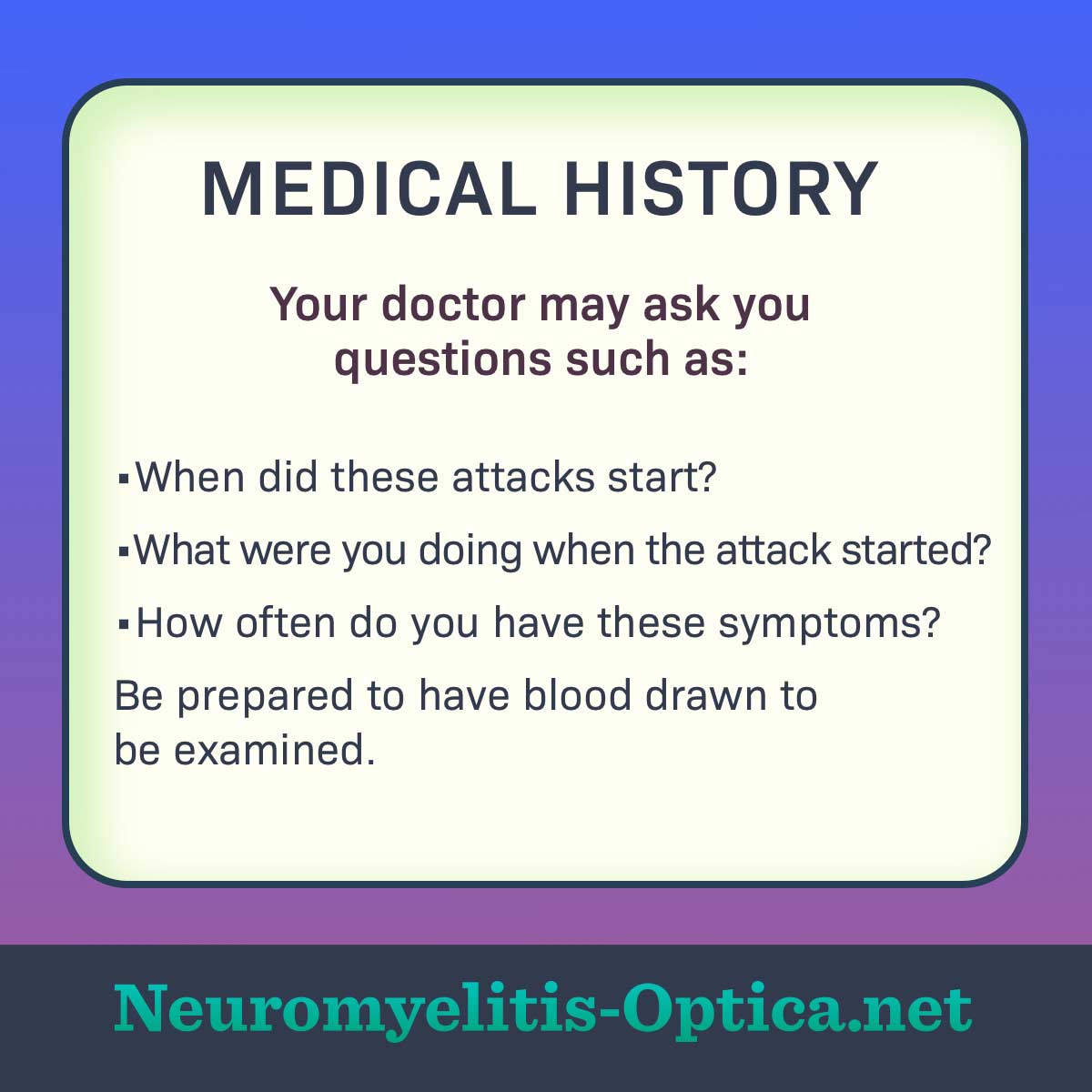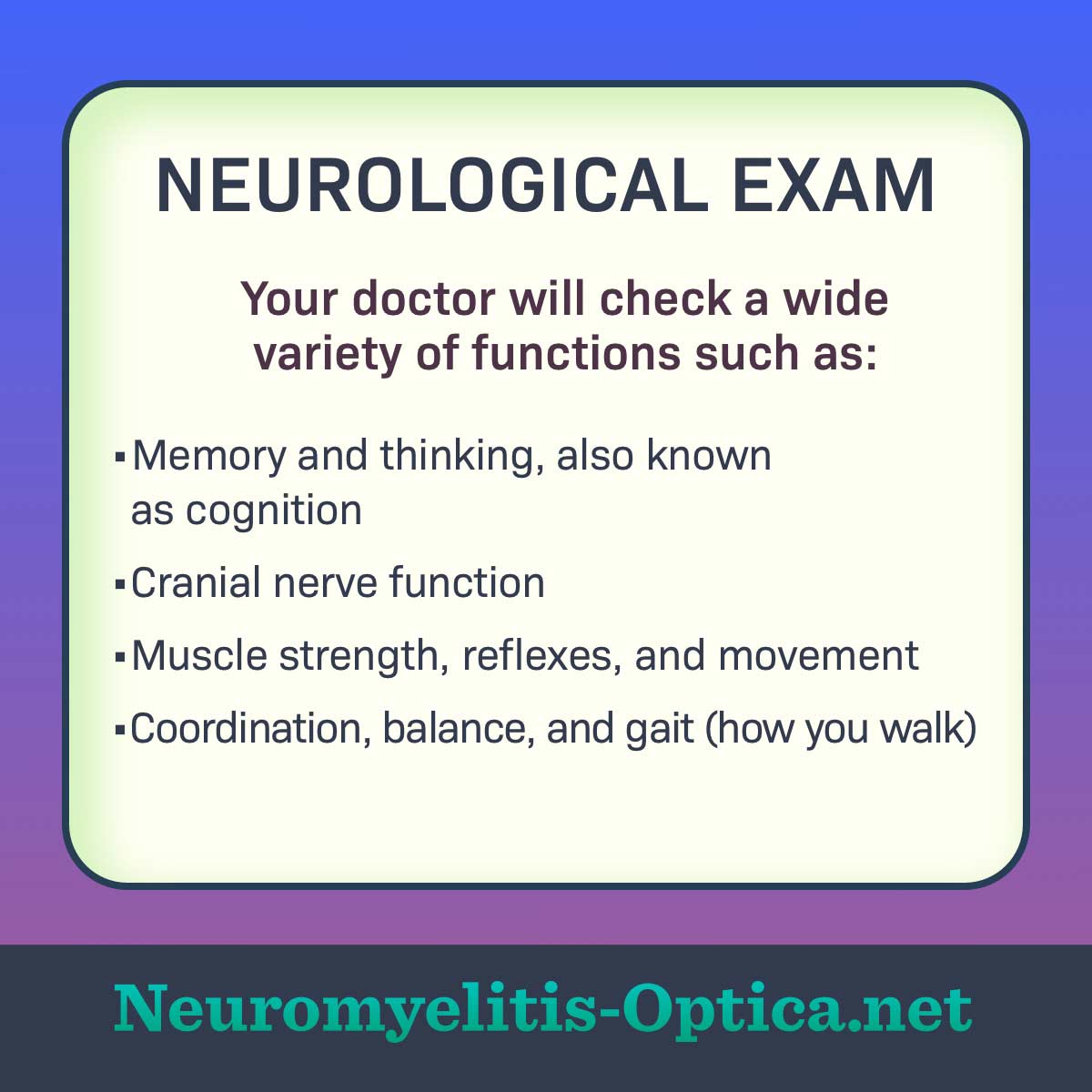Physical and Neurological Exam
Reviewed by: HU Medical Review Board | Last updated: September 2021
Neuromyelitis optica spectrum disorder (NMO) is a rare autoimmune inflammatory disease of the central nervous system (eye nerves, spinal cord, and brain). NMO may also be called neuromyelitis optica or NMO.1
It is important that the proper tests and exams are performed to get the diagnosis you need. NMO mimics other severe brain and nerve diseases, and treatment differs among these diseases. To diagnose NMO, your doctor will conduct a physical exam and order a series of tests. They may also order or perform a neurological exam.1
Physical exam
A physical exam includes weighing you and checking your blood pressure, heart rate, and temperature. The doctor will also check the other organ systems in your body. This includes looking at your eyes and ears, tapping on certain areas, and listening to your heart and breathing. This gives the doctor basic information about your overall health.
After the physical exam, your doctor or another doctor may conduct a neurological exam. A neurological exam is a detailed and specialized physical exam performed by a neurologist. This checks your brain and nerve function.
While a doctor will be the person taking note of your health history and performing the exam, you play an important role in this process.
An accurate, detailed description of symptoms
Be ready to describe your medical history in detail and as accurately as possible. Come with a list of the medicines and supplements you take, and any surgeries and illnesses you have had. This may not be easy, but taking notes ahead of time can help you remember.
Questions your doctor may ask you include:1,2
- When did these attacks start?
- What were you doing when the attack started?
- How often do you have these symptoms?
- How intense are your symptoms?
- How long do the symptoms last?
- Does anyone else in your family have an autoimmune disease?
- Do you have a history of head injury from an accident or sports?
- How much do you drink?
- Do you use any prescription, over-the-counter, or recreational drugs?
- How is your sleep? Stress levels?
You may also be asked about your work, hobbies, and exercise habits.
Screening tools
In addition to talking with you, your doctor may order several tests. The results of these tests will help rule out other conditions like multiple sclerosis. These tests may include:1-3
- MRI (magnetic resonance imaging) of the brain, optic nerve, and spinal cord
- Neurological exam
- Blood work, including tests for aquaporin-4 (AQP4) and myelin oligodendrocyte glycoprotein (MOG) antibodies, which can point to an NMO diagnosis
- Urinalysis
- Spinal tap
- Eye exam
- Stimuli response test (evoked potentials test)
Neurological exam
A neurological exam is a series of tests that look at how your brain and nerves work. This test is usually done by a neurologist. This is a doctor who specializes in the brain and nervous system.3,4
Brain and nerve exams
Your neurologist will check a wide variety of functions during your brain and nerve exam (neurological exam), such as:3,4
- Memory and thinking (cognition)
- Cranial nerve function (nerves in the brain stem that control many parts of the body)
- Muscle strength, reflexes, and movement
- Sensations
- Coordination, balance, and gait (walk)
By talking to you, the doctor can gather information about your mood, speech, ability to remember words and name objects, ability to concentrate, and more. There will also be simple tests to measure your balance, strength, reflexes, gait, and coordination.
These tests can give your neurologist a sense of the overall health of your nervous system. These are not a measure of intelligence.
What happens during these tests?
Several simple actions are used to test how well someone’s brain and nerves are working. Examples include:3,4
- Walk in a straight line, on tip-toe, balancing on 1 foot, or with both feet on the ground and eyes closed
- Touch a finger to your nose and then to the doctor’s finger
- Grip the doctor’s hand
- Hold your arms out straight for 10 seconds with your eyes closed
- Push against the doctor with the arms or legs
- Follow an object with your eyes
- Smile, turn your head, shrug your shoulders, stick your tongue out, and open and close your eyes
- Answer questions about the day of the week, the time of day, what you had for breakfast, or a recent vacation
- Do simple math or remember the names of objects
The doctor may also tap your knees, arms, or feet with a rubber hammer to check your reflexes.
If a stimuli response test is ordered, the doctor will attach electrodes to your head, earlobes, neck, arm, leg, and back. A machine will record how your brain responds to sounds, sights, and touch. This helps your doctor find lesions or damaged nerves. You may hear this test called an evoked potentials or evoked response test.3
During follow-up visits, the results of the first neurological exam will be used as a baseline. Changes in these tests over time help your doctor better understand your NMO. This baseline also helps your doctor know if your medicines are causing unwanted side effects.1

